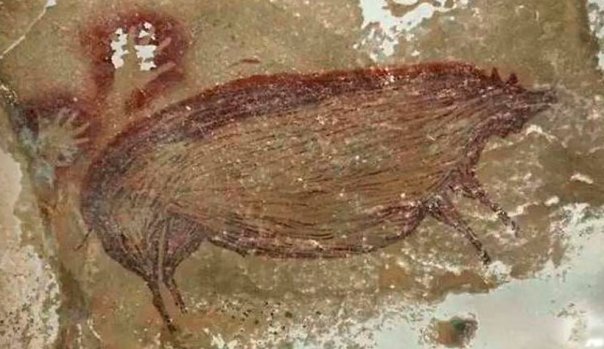An ancient painting in Sulawesi might be the first recorded narrative in human history — and it didn’t come from Europe.
In the humid highlands of southern Sulawesi, Indonesia, a fig tree winds its way up a cliff face, concealing the narrow entrance to a cave that has lain undisturbed for tens of thousands of years. Behind its mouth, a secret waited—etched in ochre and time.
There, amid the limestone walls of Leang Bulu’ Sipong 4, a team of scientists discovered what may be the oldest known narrative art ever found: a 44,000-year-old scene of what appears to be humans hunting wild pigs and a dwarf buffalo species.
But this isn’t just prehistoric scribbling. The figures, painted in reddish-brown pigment, are organized. They are doing something. And that something is telling a story.
A Remarkable Discovery in the Jungle
The man who first saw the painting wasn’t even there to find it.
Hamrullah, an Indonesian archaeologist and passionate spelunker, had climbed into the cave using a fig tree for support. Once inside, he spotted the faded yet striking image and snapped a blurry photo with his phone. He sent it to his Australian colleague, Adam Brumm, a researcher at Griffith University in Brisbane.
“I think I said the characteristic Australian four-letter word out very loud,” Brumm told the BBC.
In that moment, Brumm knew they had stumbled onto something extraordinary.

Figures Half-Human, Half-Beast
The painting, which stretches over 14 feet of cave wall, depicts at least eight figures armed with what appear to be spears or ropes. They are surrounding and hunting native Sulawesi animals: warty pigs and anoas, a small species of buffalo found only in Indonesia.
But the real twist is in the hunters themselves.
Many appear to have animal-like features — tails, snouts, elongated limbs — suggesting they may be therianthropes, mythical hybrids that blend human and animal traits. It’s a motif seen later in mythology around the world but rarely this far back in time.
“We don’t know what it means, but it seems to be about hunting and maybe has mythological or supernatural connotations,” said Brumm.
Dating the World’s First “Story”
To determine the painting’s age, archaeologist Maxime Aubert and his team used uranium-series dating—not on the paint itself, which is difficult to analyze, but on the calcite “popcorn” that had formed over parts of the image.
By analyzing radioactive decay in those mineral deposits, they found:
-
One of the pigs had calcite dated to at least 43,900 years ago
-
Two anoas had mineral build-up dated to over 40,900 years ago
That makes the painting one of the oldest surviving pieces of figurative art in the world. And because the image appears to depict a coherent scene—with action, participants, and structure—it could very well be the earliest known narrative art ever created by humans.
Rewriting the Origins of Human Creativity
For decades, Western archaeologists held that narrative and figurative art emerged first in Europe, citing examples like:
-
The Chauvet Cave in France (~30,000–36,000 years ago)
-
El Castillo in Spain (~40,000 years ago)
-
The Lascaux Caves, with detailed hunting scenes dated to around 17,000 years ago
But discoveries in Southeast Asia over the past decade have started to challenge that Eurocentric narrative.
“It has always been assumed that the tradition of figurative painting arose in Europe,” said Alistair Pike, an archaeologist at the University of Southampton. “This shows the tradition does not have its origins in Europe.”
In fact, Sulawesi alone has now yielded more than 240 cave sites with rock art, many dating older than Europe’s Ice Age masterpieces. And in 2014, another painting in Sulawesi—of a pig—was dated to at least 45,500 years ago, making it the oldest known animal drawing.
A Mythology Older Than Time?
What sets this new painting apart isn’t just its age. It’s the suggestion of symbolic thinking—that these early humans imagined beings that were not strictly of this world.
Therianthropes, like the jackal-headed Anubis of ancient Egypt or the part-deer, part-man gods of Native American lore, have long been interpreted as signs of spiritual or mythological belief.
That such concepts existed 44,000 years ago in Indonesia suggests a much earlier—and more widespread—birth of mythology than previously believed.
“It suggests they were capable of imagining things that don’t exist in nature,” Brumm said. “That’s a huge cognitive leap.”
The Problem of Dating What Can’t Be Measured
Despite the excitement, questions remain. The calcite “popcorn” did not form over the hybrid hunters themselves, meaning scientists can’t date them directly. That’s led some to wonder whether they might have been added later.
But the team believes the entire composition was likely created in a single event. The figures are stylistically consistent, and the narrative flow makes sense only when viewed as a whole.
“There’s no reason to believe it wasn’t all painted at once,” said Aubert. “It’s one story.”
Looking Backward to See Ourselves
This finding doesn’t just shift the center of artistic innovation—it adds depth to our understanding of early humans in Southeast Asia, a region often overlooked in favor of Europe and Africa.
In telling stories, our ancestors did more than decorate cave walls. They laid the foundations of religion, of myth, of identity. They imagined beings that straddled two worlds—part man, part animal—and used pigment and limestone to bring them to life.
In a way, the figures of Sulawesi are still hunting.
Not for pigs or buffalo—but for meaning, for memory, for a place in the great story of what it means to be human.













